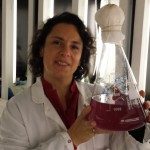Lien vers Pubmed [PMID] – 28489343
Lien DOI – 10.1021/acschembio.7b00093
ACS Chem Biol 2017 Jul; 12(7): 1796-1804
Cyanobacteria produce a wide range of natural products with antifungal bioactivity. The cyclic glycosylated lipopeptides of the hassallidin family have potent antifungal activity and display a great degree of chemical diversity. Here, we report the discovery of a hassallidin biosynthetic gene cluster from the filamentous cyanobacterium Planktothrix serta PCC 8927. The hassallidin gene cluster showed heavy rearrangement and marks of genomic plasticity. Nucleotide bias, differences in GC content, and phylogenetic incongruence suggested the acquisition of the hassallidin biosynthetic gene cluster in Planktothrix serta PCC 8927 by horizontal gene transfer. Chemical analyses by liquid chromatography and mass spectrometry demonstrated that this strain produced hassallidin E, a new glycosylated hassallidin variant. Hassallidin E was the only structural variant produced by Planktothrix serta PCC 8927 in all tested conditions. Further evaluated on human pathogenic fungi, hassallidin E showed an antifungal bioactivity. Hassallidin production levels correlated with nitrogen availability, in the only nitrogen-fixing Planktothrix described so far. Our results provide insights into the distribution and chemical diversity of cyanobacterial antifungal compounds as well as raise questions on their ecological relevance.








